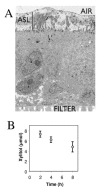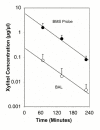Bronchoscopic assessment of airway retention time of aerosolized xylitol
- PMID: 16483382
- PMCID: PMC1386668
- DOI: 10.1186/1465-9921-7-27
Bronchoscopic assessment of airway retention time of aerosolized xylitol
Abstract
Background: Human airway surface liquid (ASL) has abundant antimicrobial peptides whose potency increases as the salt concentration decreases. Xylitol is a 5-carbon sugar that has the ability to lower ASL salt concentration, potentially enhancing innate immunity. Xylitol was detected for 8 hours in the ASL after application in airway epithelium in vitro. We tested the airway retention time of aerosolized iso-osmotic xylitol in healthy volunteers.
Methods: After a screening spirometry, volunteers received 10 ml of nebulized 5% xylitol. Bronchoscopy was done at 20 minutes (n = 6), 90 minutes (n = 6), and 3 hours (n = 5) after nebulization and ASL was collected using microsampling probes, followed by bronchoalveolar lavage (BAL). Xylitol concentration was measured by nuclear magnetic resonance spectroscopy and corrected for dilution using urea concentration.
Results: All subjects tolerated nebulization and bronchoscopy well. Mean ASL volume recovered from the probes was 49 +/- 23 microl. The mean ASL xylitol concentration at 20, 90, and 180 minutes was 1.6 +/- 1.9 microg/microl, 0.6 +/- 0.6 microg/microl, and 0.1 +/- 0.1 microg/microl, respectively. Corresponding BAL concentration corrected for dilution was consistently lower at all time points. The terminal half-life of aerosolized xylitol obtained by the probes was 45 minutes with a mean residence time of 65 minutes in ASL. Corresponding BAL values were 36 and 50 minutes, respectively.
Conclusion: After a single dose nebulization, xylitol was detected in ASL for 3 hours, which was shorter than our in vitro measurement. The microsampling probe performed superior to BAL when sampling bronchial ASL.
Figures




References
-
- Huttner KM, Bevins CL. Antimicrobial peptides as mediators of epithelial host defense. Pediatr Res. 1999;45:785–794. - PubMed
Publication types
MeSH terms
Substances
Grants and funding
LinkOut - more resources
Full Text Sources
Medical

